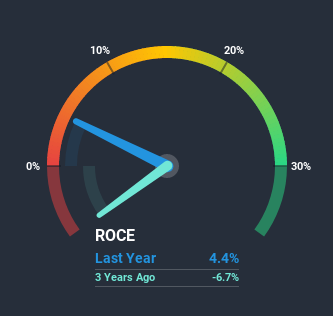- Australia
- /
- Oil and Gas
- /
- ASX:ERA
Will the Promising Trends At Energy Resources of Australia (ASX:ERA) Continue?
What trends should we look for it we want to identify stocks that can multiply in value over the long term? In a perfect world, we'd like to see a company investing more capital into its business and ideally the returns earned from that capital are also increasing. This shows us that it's a compounding machine, able to continually reinvest its earnings back into the business and generate higher returns. Speaking of which, we noticed some great changes in Energy Resources of Australia's (ASX:ERA) returns on capital, so let's have a look.
What is Return On Capital Employed (ROCE)?
If you haven't worked with ROCE before, it measures the 'return' (pre-tax profit) a company generates from capital employed in its business. To calculate this metric for Energy Resources of Australia, this is the formula:
Return on Capital Employed = Earnings Before Interest and Tax (EBIT) ÷ (Total Assets - Current Liabilities)
0.044 = AU$34m ÷ (AU$1.0b - AU$229m) (Based on the trailing twelve months to December 2020).
So, Energy Resources of Australia has an ROCE of 4.4%. On its own that's a low return on capital but it's in line with the industry's average returns of 4.4%.
Check out our latest analysis for Energy Resources of Australia

While the past is not representative of the future, it can be helpful to know how a company has performed historically, which is why we have this chart above. If you're interested in investigating Energy Resources of Australia's past further, check out this free graph of past earnings, revenue and cash flow.
The Trend Of ROCE
It's great to see that Energy Resources of Australia has started to generate some pre-tax earnings from prior investments. The company was generating losses five years ago, but now it's turned around, earning 4.4% which is no doubt a relief for some early shareholders. At first glance, it seems the business is getting more proficient at generating returns, because over the same period, the amount of capital employed has reduced by 20%. Energy Resources of Australia could be selling under-performing assets since the ROCE is improving.
For the record though, there was a noticeable increase in the company's current liabilities over the period, so we would attribute some of the ROCE growth to that. The current liabilities has increased to 23% of total assets, so the business is now more funded by the likes of its suppliers or short-term creditors. It's worth keeping an eye on this because as the percentage of current liabilities to total assets increases, some aspects of risk also increase.
The Bottom Line
In the end, Energy Resources of Australia has proven it's capital allocation skills are good with those higher returns from less amount of capital. Given the stock has declined 15% in the last five years, this could be a good investment if the valuation and other metrics are also appealing. That being the case, research into the company's current valuation metrics and future prospects seems fitting.
One final note, you should learn about the 2 warning signs we've spotted with Energy Resources of Australia (including 1 which is potentially serious) .
While Energy Resources of Australia may not currently earn the highest returns, we've compiled a list of companies that currently earn more than 25% return on equity. Check out this free list here.
When trading Energy Resources of Australia or any other investment, use the platform considered by many to be the Professional's Gateway to the Worlds Market, Interactive Brokers. You get the lowest-cost* trading on stocks, options, futures, forex, bonds and funds worldwide from a single integrated account. Promoted
Valuation is complex, but we're here to simplify it.
Discover if Energy Resources of Australia might be undervalued or overvalued with our detailed analysis, featuring fair value estimates, potential risks, dividends, insider trades, and its financial condition.
Access Free AnalysisThis article by Simply Wall St is general in nature. It does not constitute a recommendation to buy or sell any stock, and does not take account of your objectives, or your financial situation. We aim to bring you long-term focused analysis driven by fundamental data. Note that our analysis may not factor in the latest price-sensitive company announcements or qualitative material. Simply Wall St has no position in any stocks mentioned.
*Interactive Brokers Rated Lowest Cost Broker by StockBrokers.com Annual Online Review 2020
Have feedback on this article? Concerned about the content? Get in touch with us directly. Alternatively, email editorial-team (at) simplywallst.com.
About ASX:ERA
Energy Resources of Australia
Engages in mine rehabilitation in Australia.
Slight risk with mediocre balance sheet.
Similar Companies
Market Insights
Community Narratives




